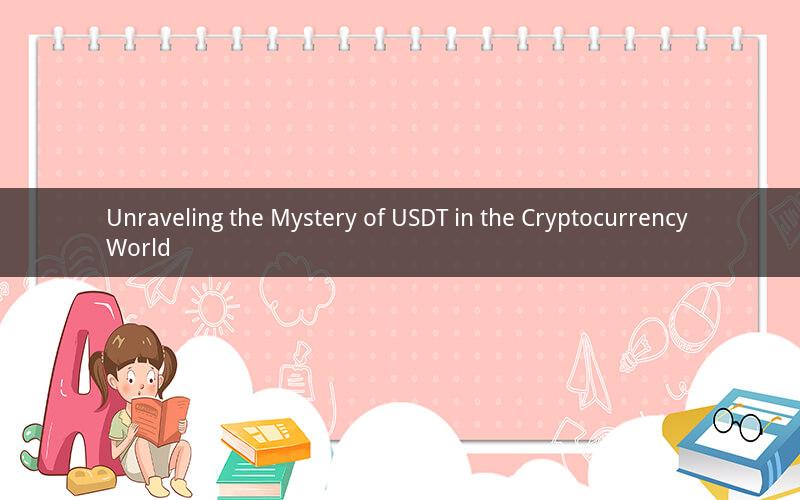
Introduction:
In the vast world of cryptocurrencies, there exists a term that has gained significant attention and intrigue: USDT. But what does USDT mean in the cryptocurrency realm? This article delves into the origins, functionalities, and implications of USDT, providing a comprehensive understanding of its role within the crypto ecosystem.
1. Understanding USDT:
USDT, short for Tether, is a type of cryptocurrency that operates on various blockchain platforms, including Bitcoin, Ethereum, and Tron. It is a stablecoin, meaning its value is pegged to a fiat currency, in this case, the US dollar. Unlike other cryptocurrencies, USDT aims to provide stability and reduce volatility, making it an attractive choice for investors and traders.
2. The Creation of Tether:
Tether was launched in 2014 by Tether Limited, a financial technology company. The primary objective behind the creation of USDT was to provide a stable and reliable digital currency that could be used for transactions, payments, and as a store of value. By pegging USDT to the US dollar, Tether Limited aimed to ensure that the value of USDT remained relatively stable, irrespective of market fluctuations.
3. How USDT Works:
USDT operates on a 1:1 basis with the US dollar, meaning that for every USDT token, there is a corresponding US dollar held in reserve. This reserve is typically maintained in a combination of cash and cash equivalents, including deposits in banks and short-term government securities. The reserve backing the USDT tokens ensures that the value of USDT remains stable and can be redeemed for US dollars at any time.
4. Benefits of Using USDT:
a. Stability: USDT provides stability to cryptocurrency markets by acting as a stable value reference. This stability makes it an ideal choice for investors and traders who want to mitigate the risks associated with market volatility.
b. Cross-border Transactions: USDT facilitates cross-border transactions by offering a fast and cost-effective method of transferring funds. Its decentralized nature eliminates the need for intermediaries, such as banks, reducing transaction costs and increasing efficiency.
c. Payment Solutions: USDT can be used as a payment solution for online purchases, remittances, and other transactions. Its wide acceptance and ease of use make it a convenient option for individuals and businesses worldwide.
5. Risks and Concerns:
Despite its numerous benefits, USDT is not without its risks and concerns. Some of the key issues include:
a. Transparency: Tether Limited has faced criticism for its lack of transparency regarding the actual reserve backing USDT. This lack of transparency raises concerns about the true value of USDT and its ability to maintain stability.
b. Regulatory Challenges: USDT operates in a regulatory gray area, as it is not classified as a traditional currency or a security. This regulatory uncertainty poses risks to users and could potentially lead to legal and operational challenges in the future.
6. The Future of USDT:
As the cryptocurrency market continues to evolve, the role of USDT is expected to expand. With increasing adoption and integration into various blockchain platforms, USDT is likely to become an integral part of the crypto ecosystem. However, the future of USDT will depend on its ability to address the concerns and challenges it currently faces.
Frequently Asked Questions:
1. Q: What is the difference between USDT and other cryptocurrencies?
A: USDT is a stablecoin that aims to maintain a stable value, while other cryptocurrencies, like Bitcoin or Ethereum, are subject to market volatility. USDT is pegged to the US dollar, ensuring its value remains relatively stable.
2. Q: Can I exchange USDT for other cryptocurrencies?
A: Yes, you can exchange USDT for other cryptocurrencies on various cryptocurrency exchanges. However, it is important to research and choose reputable platforms for safe and secure transactions.
3. Q: Is USDT a secure investment?
A: The security of USDT depends on the platform and exchange where you hold it. While USDT itself is a stablecoin, it is crucial to ensure that the platform you use has robust security measures to protect your investments.
4. Q: Can I use USDT for international remittances?
A: Yes, USDT can be used for international remittances. Its decentralized nature and fast transaction speeds make it an attractive option for sending money across borders.
5. Q: Is Tether Limited regulated?
A: Tether Limited operates in a regulatory gray area, as it is not classified as a traditional currency or a security. While the company has faced regulatory scrutiny, the extent of regulation varies by jurisdiction. It is important to stay informed about the regulatory landscape and exercise caution when using USDT.